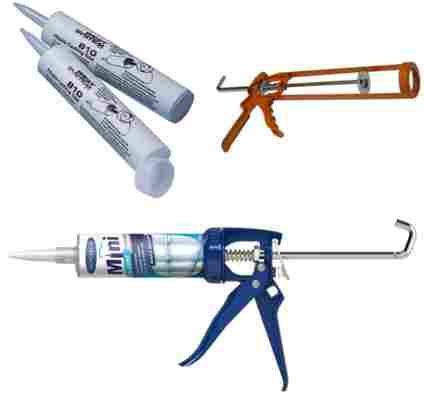According to the Environmental Protection Agency (EPA), air leaks around windows waste considerable energy. That’s why they suggest caulking as one of the fastest and cheapest remedies to help conserve energy and reduce power bills. While you might approach window caulking as a DIY project, the EPA also suggests hiring professionals for ductwork or any part of your home you don’t feel comfortable doing yourself.
What is Window Caulking?
You might buy caulk made out of acrylic latex or silicone. You may find it in a disposable cartridge or tube that fits into a caulking gun, and this is the sort of supply suggested for doing any more than a small area. Some companies also make pressurized cartridges that don’t require using a caulking gun. For very small jobs, you might also find spray cans or tubes.
Before you buy your caulk, you should know about various options:


Caulking tubes (top left); caulk gun (top right); caulking tube loaded in a caulk gun (bottom).
How Does Caulking Windows Benefit You?
Air leaks allow heat to escape in the winter and enter your home in the summer. Either way, you’ll make your HVAC system work harder than it needs to, possibly shortening the time between calling for repairs or even new units. As your system works harder, it will consume more power. Thus, you’ll pay the energy company more than you need to. At the same time, your system can’t keep you as comfortable as it could with a well-sealed and insulated home.
The EPA estimated that this simple project could save 10 to 20 percent on energy costs for a typical home and cost most people no more than $30 and a couple of hours to do it themselves. Since it’s a fairly simple task, professionals usually charge modest fees to provide this service as well.
Even if the holes don’t go all the way through, they can also cause other serious problems. Rainwater can seep through into the space between your walls and into your insulation and wiring. Besides water damage, you may have a source of mold or even electrical problems. For a quick, inexpensive job, window caulking can save you a lot of money and keep you more comfortable.
When Do You Need to Caulk Windows?
Caulking should be a priority when you install new windows and if you see any obvious gaps or holes around your existing window. If you already have caulking, check its condition. After some time, latex caulk tends to crack. Any caulk may start to pull away from the window and frame. At that time, you should re-caulk.
Of course, if you’ve never had your windows caulked, you should consider investing a very modest amount in a task that can help save you money and energy in the future.
You can also consider these tips on how you can detect tough-to-find air leaks:
Watch the Caulking Process
Skip to 9:59 for caulking process.
These instructions describe the basic caulking process:
Where You Should Not Caulk
Once you learn about all the benefits of window caulking, you might feel enthusiastic about this simple way to help conserve energy and save money.
On the other hand, you cannot apply caulk everywhere. It’s important to learn about places you should not point your caulk gun:
Time to Start Caulking!
Caulking should not take more than a couple of hours and a few dollars. In turn, you could enjoy a draft-free home and cheaper energy bills. If you decide to do it yourself or hire a professional, you should enjoy returns on your home-improvement investment right away.
Article reviewed by Dan Bawden , CAPS, GMB, CGR, CGP, and President of Legal Eagle Contractors.
